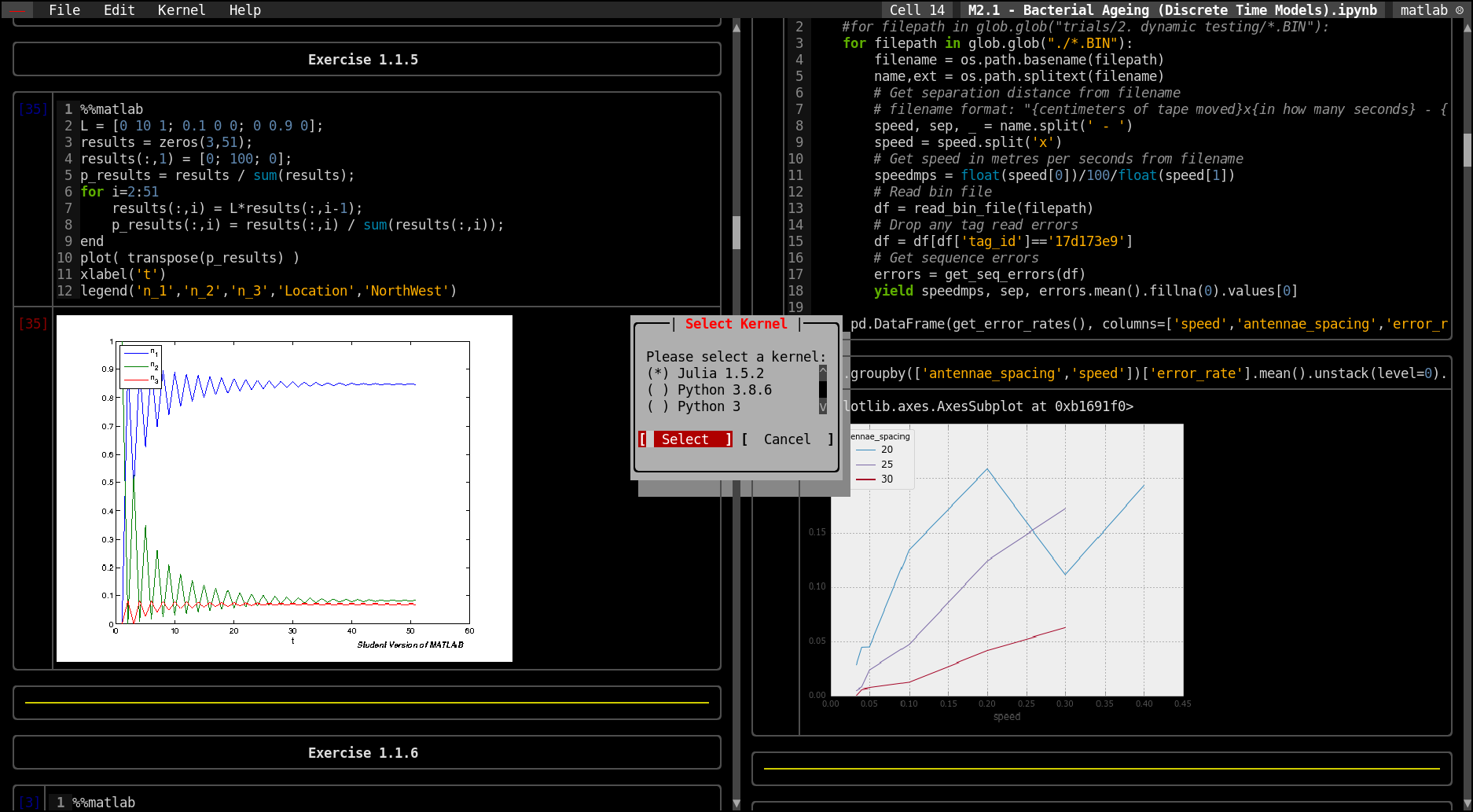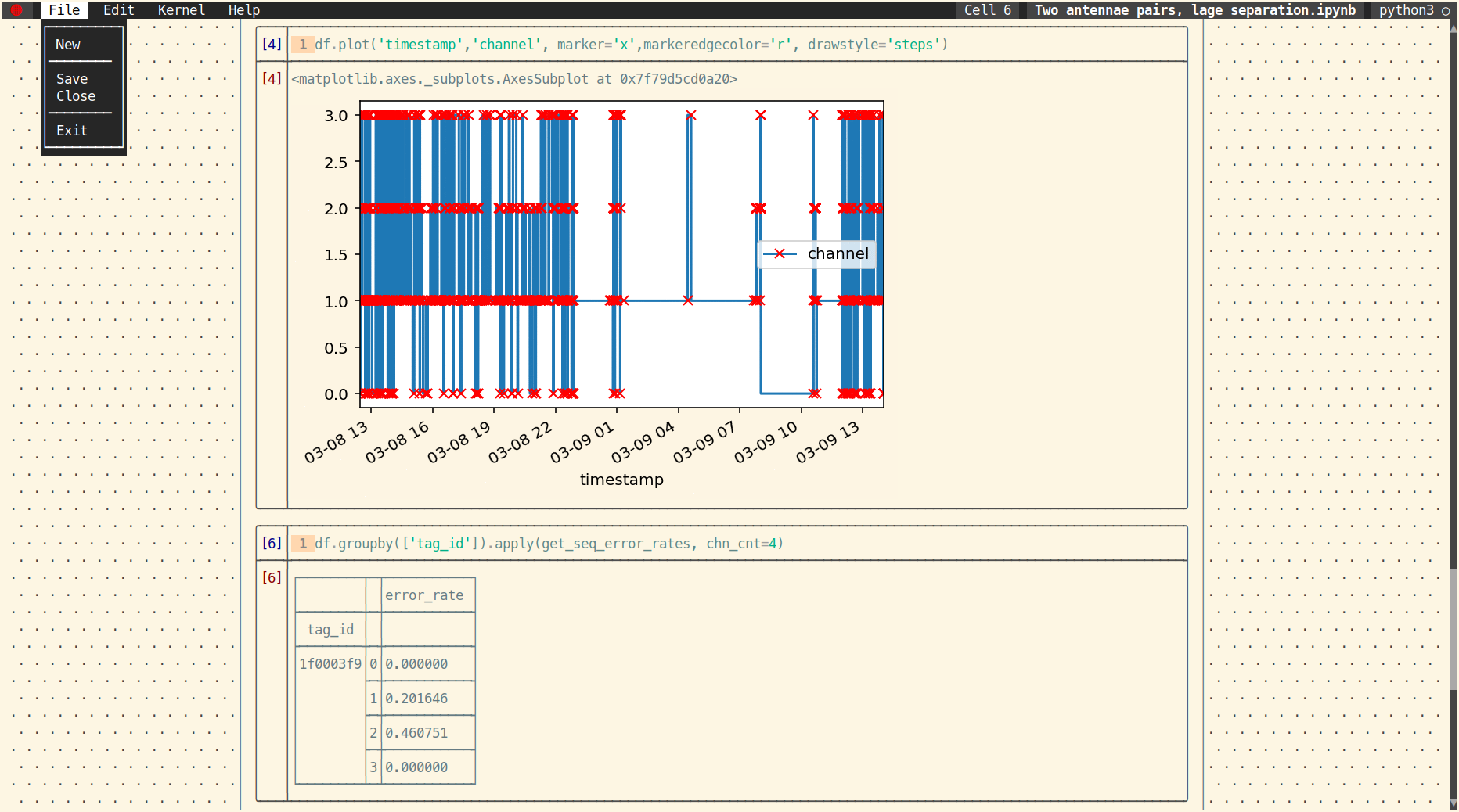Build a UI with Euporie to Run and Edit Jupyter Notebooks
Euporie is a text-based user interface for running and editing Jupyter notebooks.
Install
Euporie is on pypi, so can be installed using pip or pipx:
# install inside a virtualenv
pip install euporie
# install globally
pipx install euporie
You may wish to install some optional python dependencies to render images and HTML tables :
pip install euporie[html-mtable,images-timg]
Screenshots





Features
- Execute notebooks in the terminal
- Autocompletion in code cells
- Rich output support, including:
- Markdown
- Tables
- Images
- Open multiple notebooks side-by-side
- Good performance with large notebook files
Image Support
Euporie will attempt to render images in the best possible way it can. The following methods are supported:
Sixel
If supported by your terminal, euporie can show graphical images in cell outputs
This requires one of the following:
Kitty's terminal image protocol
If your terminal supports kitty's terminal graphics protocol, euporie will use it to render images
Ansi art
This requires one of the following:
timg
catimg
icat
timg
tiv
viu
img2unicode
jp2a
img2txt
The kitty & sixel image rendering methods will fall back to ansi art images when rendering images in partially obscured cells, to prevent clipped images destroying the user interface.
For SVG support, cairosvg or imagemagik are required.
HTML Support
Euporie will attempt to render HTML outputs. This requires one of the following:
Note: only HTML tables will be displayed if mtable is used
If none of these commands are found in your $PATH, the plain text representation will be used.
Usage
usage: euporie [-h] [--verion] [--dump | --no-dump] [--dump-file [Path]]
[--page | --no-page] [--key-map {emacs,vi}]
[--run-after-external-edit bool] [--max-notebook-width int]
[--background-pattern {0,1,2,3,4}] [--background-character str]
[--line-numbers | --no-line-numbers] [--syntax-theme str]
[Path ...]
positional arguments:
Path List of file names to open
optional arguments:
-h, --help show this help message and exit
--verion, -V show program's version number and exit
--dump, --no-dump Output formatted file to display or file
--dump-file [Path] Output path when dumping file
--page, --no-page Pass output to pager
--key-map {emacs,vi} Key-binding mode for text editing
--run-after-external-edit bool
Run cells after editing externally
--max-notebook-width int
Maximum width of notebooks
--background-pattern {0,1,2,3,4}
The background pattern to use
--background-character str
Character for background pattern
--line-numbers, --no-line-numbers
Show or hide line numbers
--syntax-theme str Syntax higlighting theme
Key Bindings
| Key Binding | Command |
|---|---|
| Application | |
| ctrl-n | Create a new notebook file |
| ctrl-o | Open file |
| ctrl-w | Close the current file |
| ctrl-q | Quit euporie |
| ctrl-s | Save current file |
| Navigation | |
| tab | Focus next element |
| shift-tab | Focus previous element |
| [ | Scroll up |
| ] | Scroll down |
| ctrl-up / home | Go to first cell |
| pageup | Go up 5 cells |
| up / k | Go up one cell |
| down / j | Go down one cell |
| pagedown | Go down 5 cells |
| ctrl-down / end | Go to last cell |
| Notebook | |
| a | Add new cell above |
| b | Add new cell below |
| d d | Delete current cell |
| x | Cut current cell |
| c | Copy current cell |
| v | Paste copied cell |
| m | Change cell to markdown |
| y | Change cell to code |
| r | Change cell to raw |
| l | Toggle line numbers |
| e | Edit cell in $EDITOR |
| enter | Enter cell edit mode |
| escape | Exit cell edit mode* |
| escape escape | Exit cell edit mode quickly |
| ctrl-enter / ctrl-e | Run cell** |
| shift-enter / ctrl-r | Run then select next cell** |
| Edit Mode | |
| ctrl-f | Find |
| ctrl-g | Find Next |
| ctrl-z | Undo |
| ctrl-d | Duplicate line |
| tab | Indent |
| shift-tab | Unindent |
| ctrl-c | Copy |
| ctrl-x | Cut |
| ctrl-v | Paste |
* There is a slight delay detecting an escape key-event. To exit edit mode quickly, double-press the escape key.
** These entries require your terminal to support CSI-u mode. If your terminal does not support this, it may be possible to work around this by remapping the keys in your terminal emulator - see below).
When in edit mode, emacs style key-bindings apply.
Key Remapping
By default, VT100 terminal emulators do not distinguish between Enter, Ctrl + Enter & Shift + Enter. In order to work around this, it is possible to re-map these key bindings so they produce the escape code of another key. To replicate the Ctrl + Enter & Shift + Enter of Jupyter, you will need to remap the following shortcuts in your terminal:
| Key Combination | Output |
|---|---|
| Ctrl + Enter | Ctrl + F20 |
| Shift + Enter | F21 |
xterm
Add the following to your ~/.Xresources
*.vt100.translations: #override \n\
Ctrl <Key>Return: string("\033\[19;6~") \n\
Shift <Key>Return: string("\033\[20;2~") \n\
konsole
In the menu, navigate to:
Settings -> Edit Current Profile -> Keyboard -> Edit
Change the existing entry for Return+Shift to Return+Shift+Ctrl (or whatever you prefer), then add the following entries:
| Key combination | Output |
|---|---|
| Return+Ctrl | \E\[19;6~ |
| Return+Shift | \E\[20;2~ |
Roadmap
- Add ability to dump formatted notebooks
- Add command line argument parsing
- Render outputs asynchronously in a separate thread
- Upstream markdown tables in rich
- Cell attachments
- LaTeX
- Widgets
Download Details:
Author: joouha
Official Website: https://github.com/joouha/euporie